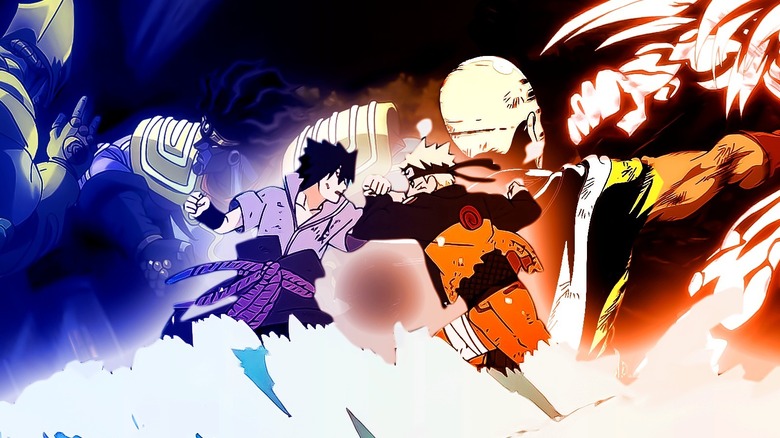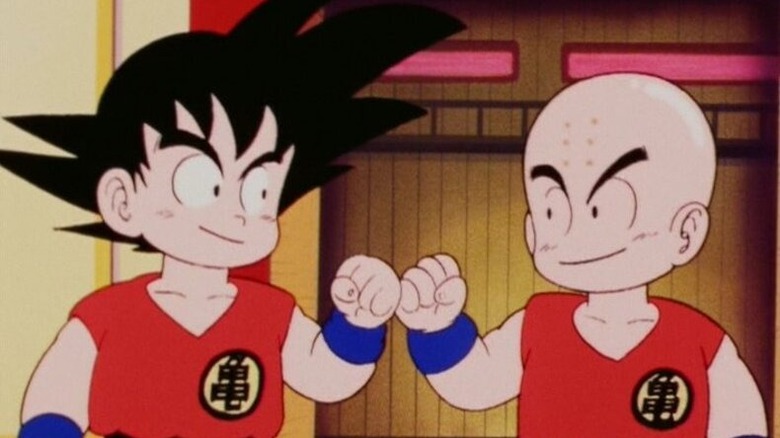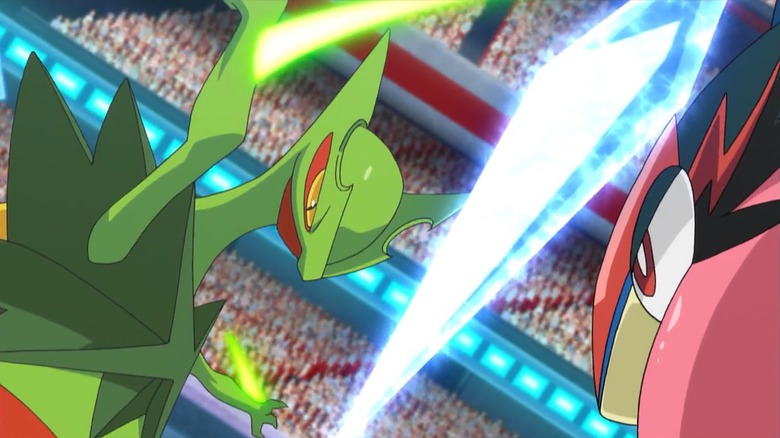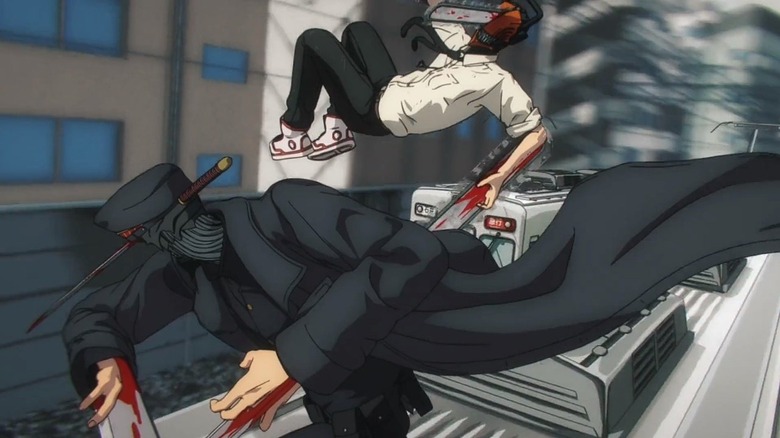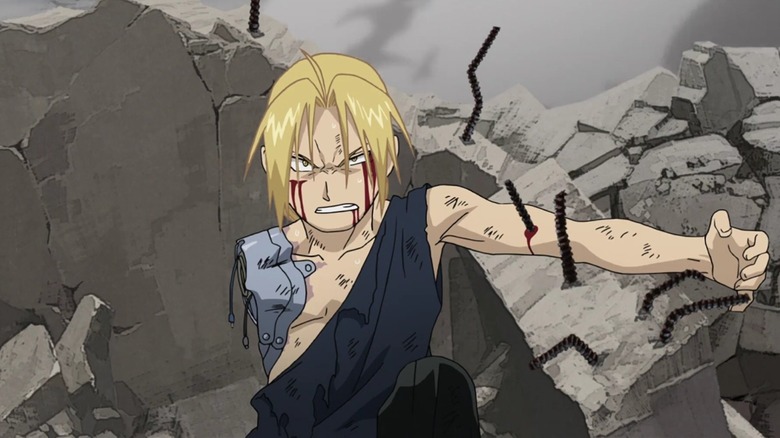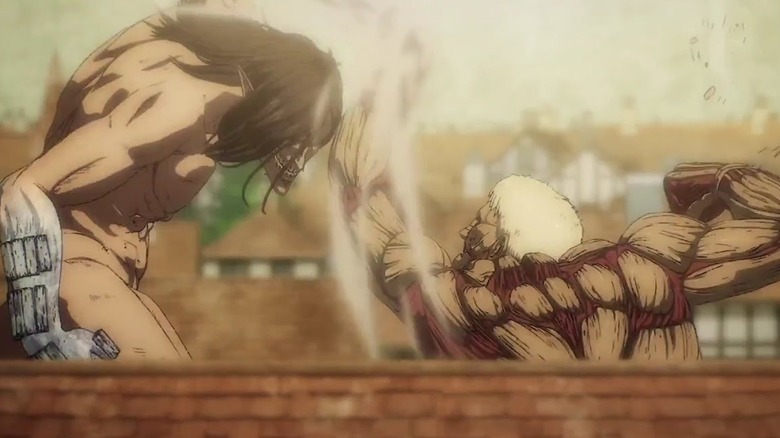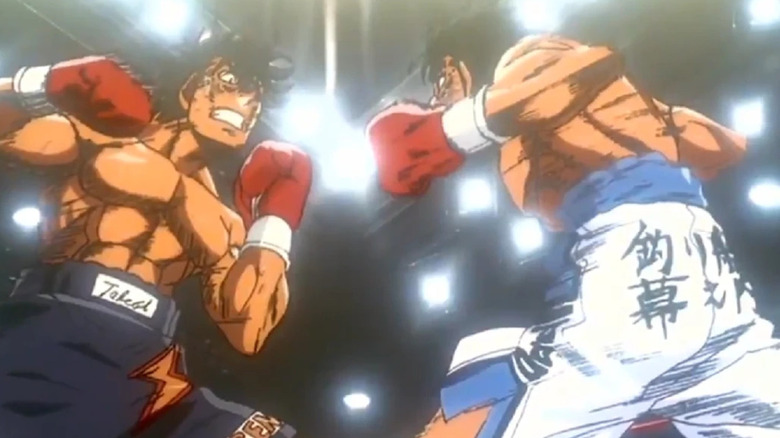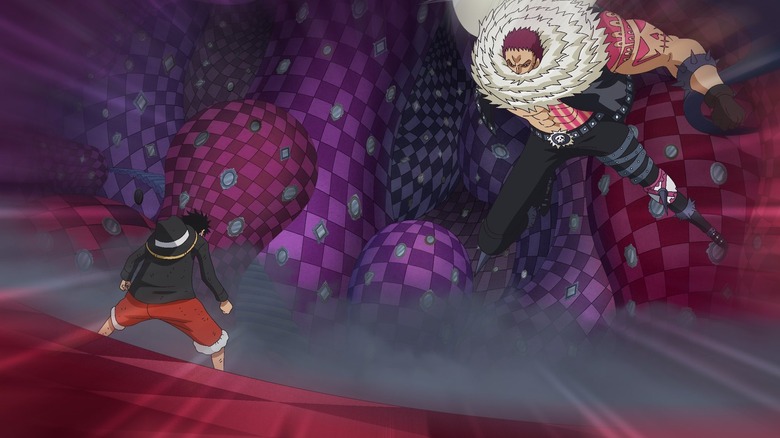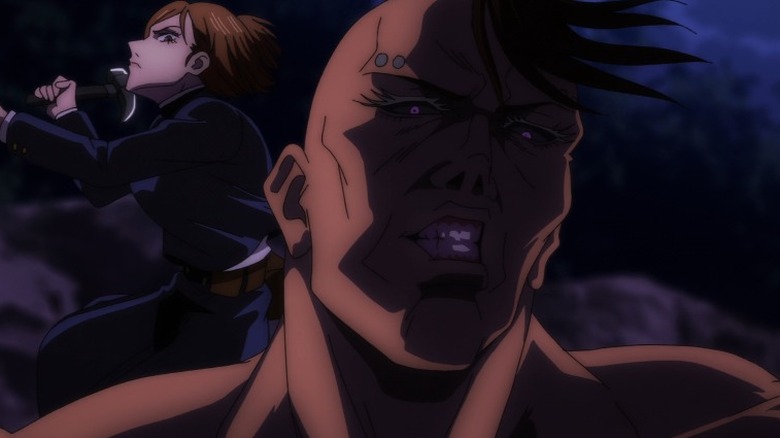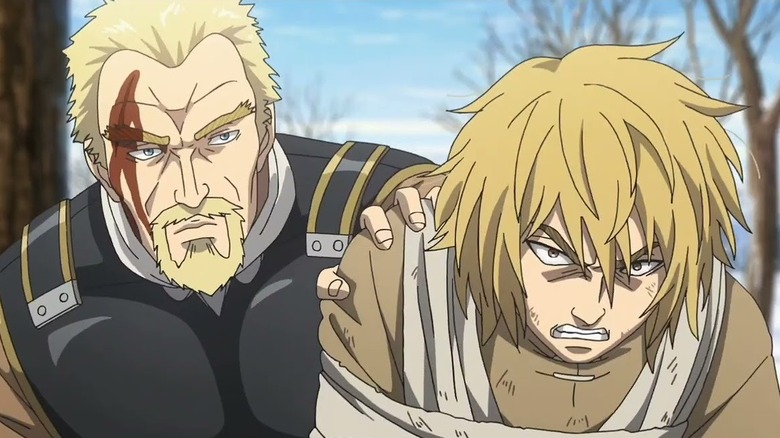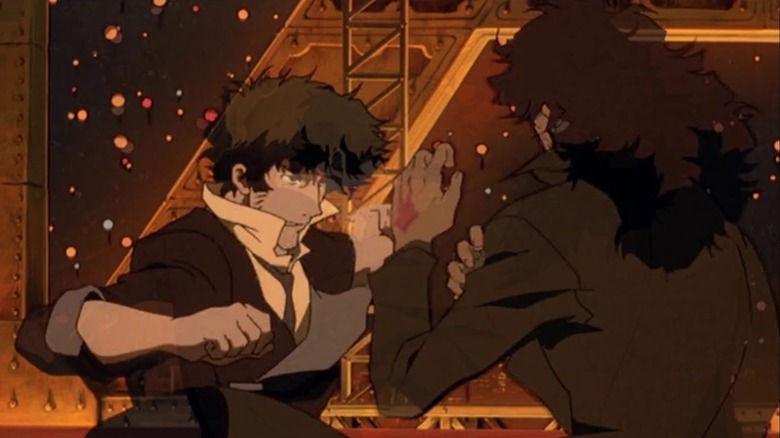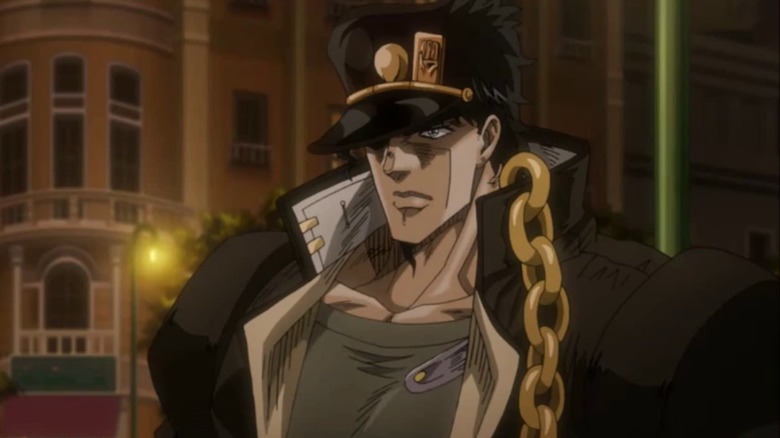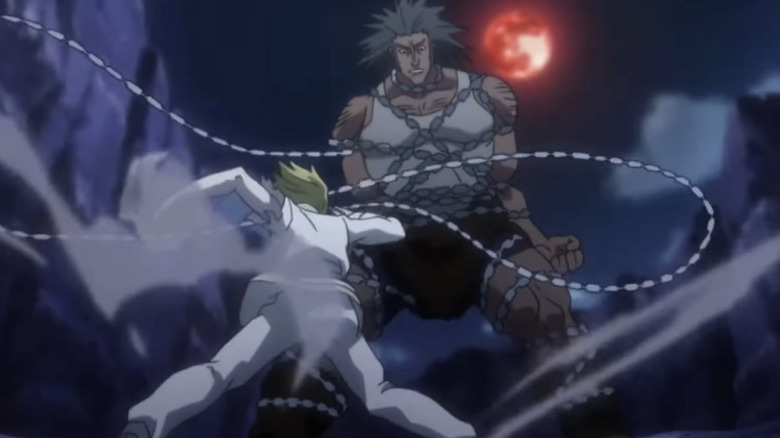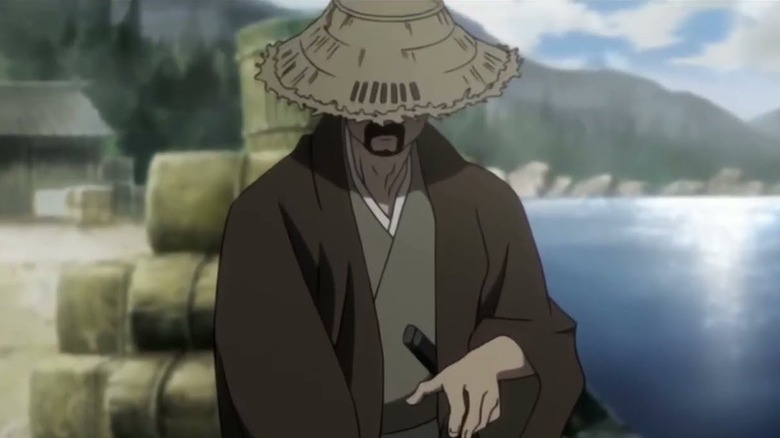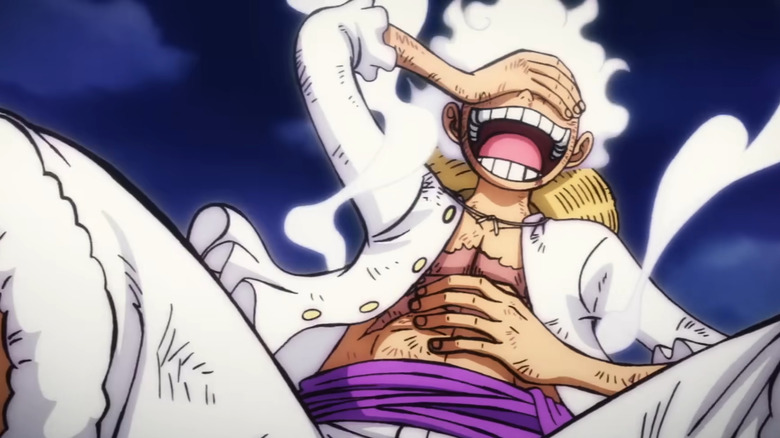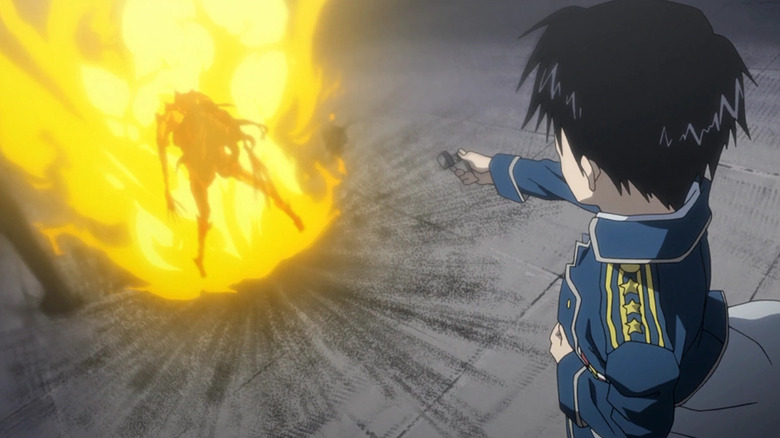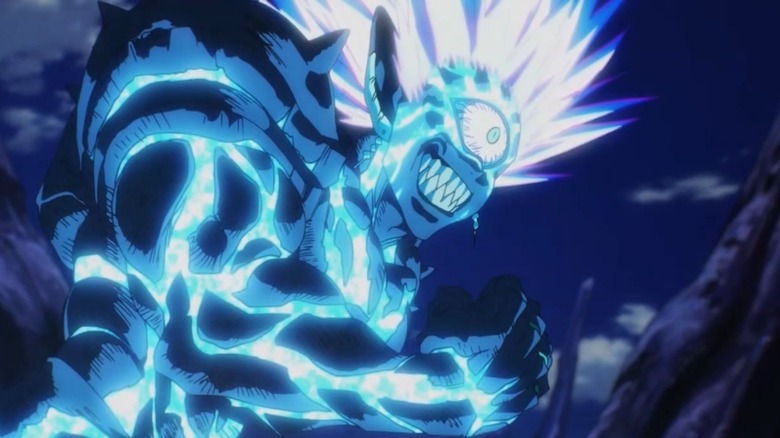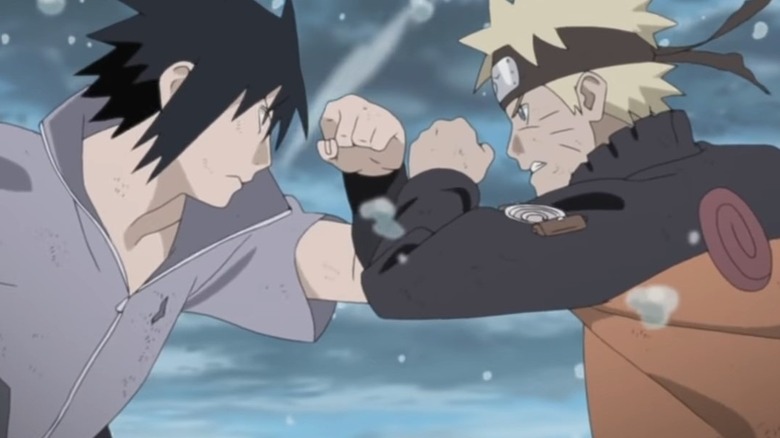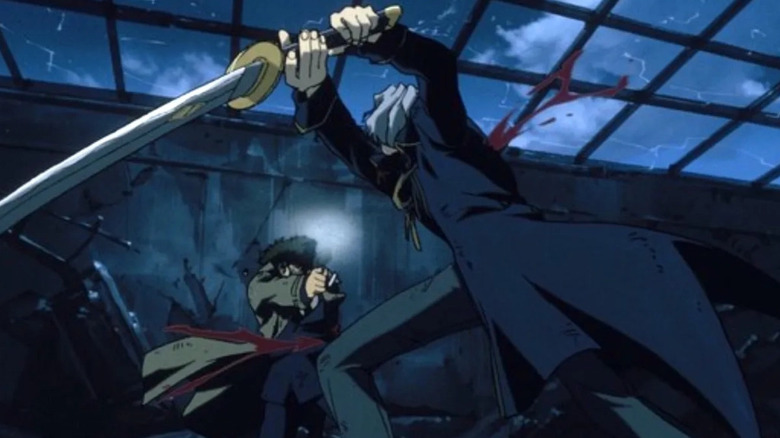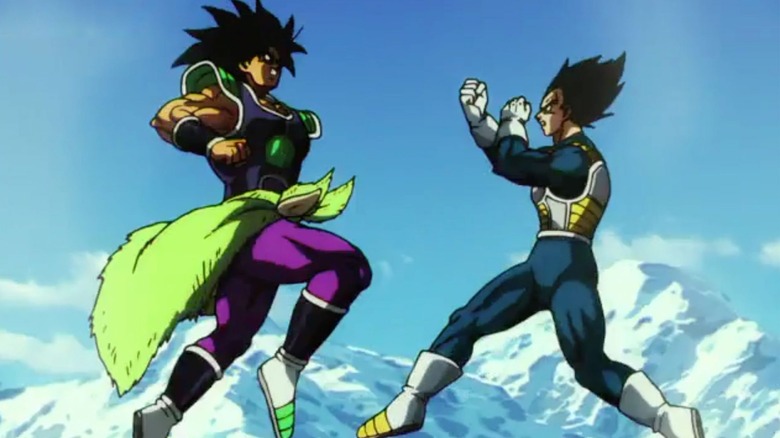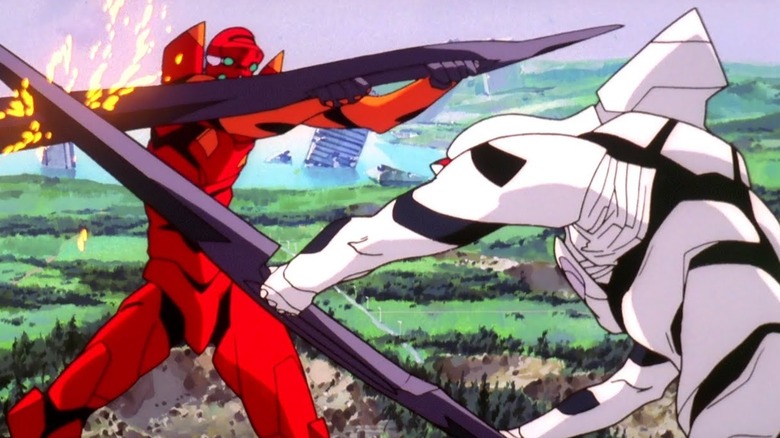The Top 20 Anime Fights Of All Time, Ranked
We may receive a commission on purchases made from links.
With its sense of kinetic animation, stylized choreography, and tendency to heighten spectacle for the sake of emotional stakes and scope, the anime medium has some of the best-rendered fight sequences in animation or live-action. Considering the ever-present reminder that anime is a medium, not a genre as occasionally misattributed, the fights can be as sci-fi as a multiversal martial arts tournament to a serene duel between samurai. With that in mind, here are the 20 best anime fights of all time, from the early days of concerted fight staging with the original '80s "Dragon Ball" to memorable scuffles from contemporary anime series.
Across such an exhaustive medium, many of the fights included in this article could stand as anime's very best, but we've narrowed it down to singular, standout battles within different series and movies. Whether serving as the explosive punctuation to longstanding rivalries and character arcs or incorporating unique tactics and techniques, anime has delivered some truly impressive action set pieces. With anime becoming an increasingly prominent fixture of the mainstream, here are the best fights that the medium has to offer that everyone from seasoned fans to newcomers should check out.
20. Dragon Ball (Goku vs. Krillin)
In a lot of ways, "Dragon Ball" is both the gateway for a lot of viewers into the anime medium and a standard for anime fights, with everything from conventional martial arts to high-flying, energetic battles. The original "Dragon Ball" series, depicting the coming-of-age of the franchise's protagonist Goku, featured martial arts skirmishes from the beginning, but the intensity and scope of these fights really found their footing approximately halfway through. This is visibly apparent during the tournament bout between Goku and Krillin at the World Martial Arts tournament in the series' third season.
In the lead-up to the tournament, Goku and Krillin had trained separately, and their fight showcased how they had each individually progressed since their last meeting, especially Goku. On a more meta-textual note, the fight also revealed how much creator Akira Toriyama had honed his fight choreography, significantly upping the speed and emotional investment in every movement. Though perhaps not the most seismic struggle "Dragon Ball" has ever had, this duel definitely marks a turning point. The bar for the franchise's fights was quietly set by Goku and Krillin's skirmish, immeasurably helping "Dragon Ball" endear itself to millions worldwide. (Samuel Stone)
19. Pokémon XYZ (Ash-Greninja vs. Mega-Sceptile)
Back in my day (2006 or so), the "Pokémon" anime had rather sluggish animation — during battles, the Pokémon would hover in a mid-air single-color void and launch an attack. If there was any motion, half the time it was conveyed with a hard cut. When I tuned into "Pokémon XYZ" (aired in 2016), I couldn't believe my eyes.
In episode 128, it's the semi-finals of the Kalos region's Pokémon League. Ash Ketchum and his Greninja (they can "bond" to become Ash-Greninja) face off against their rivals, Sawyer and his Sceptile (who can Mega Evolve into a more powerful form). This clash is far removed from the stationary Pokémon battles of my youth. The framing moves at breakneck speed, constantly zooming in and back out for lightning-quick close-ups to emphasize reactions or powerful attacks.
Watch and marvel how when Greninja's Cut and Sceptile's Lead Blade meet in mid-air, the frame swerves in toward each of their eyes before pulling back out. Feel the pain when Greninja dropkicks Sceptile's head. As Greninja dashes across and slices monstrous vines created by Sceptile's Frenzy Plant, even the frame struggles to keep up.
I'm no dub purist, but watch this fight in the original Japanese for the music. Tomohisa Sako's rocking score captures the excitement much better than Ed Goldfarb's techno tunes. "Pokémon" is aimed at a younger audience than even most battle shōnen, so it's easy to dismiss it. Even so, a great fight scene is a great fight scene. (Devin Meenan)
18. Chainsaw Man (Denji vs. Katana Man)
"Chainsaw Man" follows a group of monster hunters taking on devils evoking different animals and objects, with its protagonist Denji bonded to a devil himself to transform parts of his body into chainsaws. After the villainous Katana Man defeats Denji and escapes, Denji gets his chance at a rematch in the first season finale. The two opponents, who can both turn their appendages into deadly blades at a moment's notice, square off across the rooftops of Tokyo before their skirmish moves to a train speeding through the city.
Katana Man is one of the first enemies in "Chainsaw Man" to really put Denji in his place and nearly finish off the young monster hunter's career as it's just beginning. That lends both a heightened sense of danger and emotional investment in the rematch as Denji faces Katana Man alone, unmatched by any of the season's preceding battles. With Denji and Katana Man soaring across the cityscape before settling on a high-speed train, there is a constant sense of motion in this rematch that just makes everything feel that much more dire and thrilling. "Chainsaw Man" certainly captured a sense of grandeur before, but this first season capper blended scope with personal stakes that will hopefully set a standard moving forward. (Samuel Stone)
17. Fullmetal Alchemist: Brotherhood (Father vs. Everyone)
The latter half of "Fullmetal Alchemist: Brotherhood" has a shadowy figure known as Father unleashing the homunculi, the sinister personifications of the seven deadly sins. Father is a particularly personal enemy for protagonists Edward and Alphonse Elric, resembling their dad Van Hohenheim after being made from Hohenheim's blood. After absorbing the soul of an omnipotent being beyond the Gate of Truth, Father ascends to godhood, resulting in Edward and Alphonse leading everyone to stop the villain from subjugating humanity.
The final battle with Father brings together all the surviving allies of "Fullmetal Alchemist: Brotherhood" for what is truly the most epic fight in either anime adaptation of Hiromu Arakawa's fantasy adventure. Father shrugs off the combined military might assembled against him and it's all hands on deck in the chaotic struggle. Perhaps a bit too overwhelming — and with Alphonse's heroic sacrifice to defeat Father undone too quickly and neatly in the aftermath — the Elric brothers' last stand is still a tremendous, extended set piece. (Samuel Stone)
16. Attack on Titan (Eren vs. Reiner)
Hajime Isayama's "Attack on Titan" is part steampunk medieval fantasy, part kaiju horror as carnivorous Titans terrorize a walled city, vulnerable only in a weak point in the nape of their neck. Over the course of "Attack on Titan," protagonist Eren Yeager gains the ability to transform into a Titan himself, only to find that spies from rival kingdoms have infiltrated the military and similarly possess this power. Eren's friend Reiner Braun is among the double agents, able to transform into the Armored Titan, with the two friends' fourth battle standing as the action-packed highlight of the series.
Reiner takes part in Paradis' attack on Eren's kingdom of Shiganshina, transforming as he descends in midair to attack Eren directly, leading to a seismic brawl in the streets. Despite having greater endurance through his armored carapace, Eren is the superior hand-to-hand combatant and gets creative in how to outmaneuver his opponent in the grueling confrontation. As personal as fights in "Attack on Titan" get, Eren and Reiner's bitter brawl may go a bit too long but succinctly captures what the show is all about. (Samuel Stone)
15. Hajime no Ippo (Ippo vs. Sendo)
If there's an anime that screams "fights" is, well, the boxing anime "Hajime no Ippo." This is not only the perfect underdog sports story but a major source of inspiration to the action in "Creed III." It is easy to see why. The anime follows the story of Ippo Makunouchi as he begins his career in boxing, with the first season culminating in the exhilarating, hard-hitting championship fight between Ippo and his longtime rival and then-champion Takeshi Sendō. Even 20 years after its initial release, the fight remains one of the best in anime, thanks to its emotional resonance, storytelling, and stunning animation that gives the fight a level of gritty realism and weight we don't see in action anime anymore.
Sure, there are many current anime capable of incredibly fluid animation and action choreography, but few can replicate the sheer weight of a simple gut punch, the infectious pain of a right hook quite like "Hajime no Ippo." The Ippo vs Sendō fight is the culmination of 76 episodes of TV, of many a real-life technique learned, of fights won and lost. When Ippo delivers his final jet-engine-fueled Dempsey Roll and throws his opponent to the ground, and the original ending theme song "Yūzora no Kami Hikōki" starts playing, it's like watching Rocky finally defeat Apollo and thank Adrian, a huge moment of pure athletic catharsis. (Rafael Motamayor)
14. One Piece (Luffy vs. Katakuri)
Eiichiro Oda's "One Piece" has become an enduring global phenomenon that has run for over 20 years and 1,000 episodes as it tells the adventures of young pirate Monkey D. Luffy. Across the entire series, one of the most formidable opponents Luffy has ever faced is Big Mom Pirate Commander Charlotte Katakuri, who is a vicious hand-to-hand combatant. After several minor skirmishes, Luffy and Katakuri finally have it out in the 850th episode of "One Piece," in the most grueling challenge for Luffy yet.
In the face of Katakuri's overwhelming strength, Luffy essentially plays rope-a-dope with the rival pirate, enduring an intense, prolonged beating as Katakuri unleashes a barrage of attacks. As Katakuri begins to falter in stamina and Luffy grows accustomed to his fighting style, the Straw Hat Pirate turns the tables to defeat Katakuri in a stunning reversal. The only thing holding back Luffy and Katakuri's brawl is that Katakuri injures himself to make up for his sister Charlotte Flampe interfering in the duel in a display of honor. Still, this fight still stands head and shoulders above the rest in "One Piece" and demonstrates a quiet strategic side to the series' normally cheerful protagonist. (Samuel Stone)
13. Jujutsu Kaisen (Yuji/Nobara vs. Eso/Kechizu)
"Jujutsu Kaisen" depicts a vision of Japan packed with fiendishly personified curses that terrorize the populace, prompting a private high school to train its students on how to hunt the curses down. The most frenzied battle for the series yet comes in the two-part finale to the anime adaptation's first season, with protagonist Yuji Itadori and his friend Nobara Kugisaki taking on two powerful curses at once. As the Death Painting Curse Kechizu is cornered, his older brother Eso attacks Nobara, leaving Yuji to continue his confrontation with Kechizu alone.
This heated two-on-two fight demonstrates just how formidable Yuji and Nobara have both grown since the start of the series in their most harrowing battle yet. With Eso and Kechizu both using respectively unique attacks and operating as a team, Yuji and Nobara are similarly forced to learn how best to work together to take on the dual threat. Blending supernatural horror with frenetic magical action, the "Jujutsu Kaisen" season finale showcases what the show does best before coming to an abrupt end. (Samuel Stone)
12. Vinland Saga (Thorfinn vs. Thorkell)
Compared to the graceful martial artists and casually cool science fiction heroes leading other shows, "Vinland Saga" is nowhere near as elegant, and that's by design. In the story of obsessive revenge framed against the backdrop of England at the height of the Viking Age, protagonist Thorfinn sets out to avenge his father's death. This leads Thorfinn to face off against his own uncle, Thorkell the Tall, with the two facing each other in a bitter rematch after an earlier skirmish costs Thorkell two of his fingers.
The second fight between Thorfinn and Thorkell runs longer than their initial duel, heightening the graphic violence as the uncle and nephew square off, culminating in Thorfinn breaking an arm and Thorkell losing an eye. Though Thorfinn has grown considerably as a fighter since he last fought his uncle, Thorkell overpowers him for much of the bout, easily knocking him around as Thorfinn endures a harrowing gauntlet of punishment. The ugliest and most visceral fight in this article, the duel highlights that "Vinland Saga" is well done but may not be everyone's cup of tea. (Samuel Stone)
11. Cowboy Bebop: The Movie (Spike vs. Vincent)
Released two years after the conclusion of the main anime series, 2001's "Cowboy Bebop: The Movie" reunited much of the show's cast and crew for an all-new adventure. Set sometime during the events of the series, Spike Spiegel and his friends race to stop a terrorist named Vincent from launching an attack on the human capital on Mars. As Vincent prepares to carry out his chemical attack on a Halloween parade, Spike tracks down his adversary to a recreation of the Eiffel Tower overlooking the parade route.
All of the fight sequences in "Cowboy Bebop" are tightly choreographed while accentuating just how cool and competent Spike is, but its finale takes these sensibilities to another level. Spike and Vincent's showdown puts the viewer right in the center of its hard-hitting brawl while Spike's swagger and martial arts techniques quietly evoke those of Bruce Lee. Framed against the backdrop of Halloween on Mars under the pouring rain, this high-stakes confrontation perfectly embodies the sense of style that "Cowboy Bebop" excels at. Though, its conclusion may come a bit too clean. (Samuel Stone)
10. Jojo's Bizarre Adventure: Stardust Crusaders (Jotaro vs. Dio)
The second season of "Jojo's Bizarre Adventure," subtitled "Stardust Crusaders," sees the vampiric villain Dio Brando emerge and target protagonist Jotaro Kujo and those close to him. Possessing the ability to temporarily freeze time, Dio is a sadistic enemy who kills Jotaro's reformed friend Noriaki Kakyoin and grievously wounds his grandfather Joseph Joestar. Despite the overwhelming odds against him, Jotaro takes on Dio in a brutal brawl that spans the final three episodes of the season.
What makes this fight stand above the rest in "Jojo's Bizarre Adventure" is its sense of dynamics in dominance, with Jotaro and Dio's control over the battle alternating in surprising turns across the skirmish. Dio's limited time manipulation makes for a visually interesting action sequence, while Jotaro's strategy in turning it against the vampire underscores how brilliant a tactician he can be. Sheer spectacle, Jotaro and Dio's showdown is a long time coming and a bloody masterclass on how to maintain a viewer's attention across such a prolonged conflict. (Samuel Stone)
9. Hunter x Hunter (Kurapika vs. Uvogin)
"Hunter X Hunter" is a series about chasing your dreams; what good is a hunter without a quarry?
Kurapika may look adorable, but his dream is one of violent justice. A member of the red-eyed Kurta clan, Kurapika's people were slaughtered by the Phantom Troupe, a powerful gang of thieves. Now, he lives to hunt them, crafting himself whiplike chains with his nen (aura) — forged by his stronger-than-steel resolve — to face the Troupe. In episode 47, "Condition X and X Condition," Kurapika goes mano-a-mano with Uvogin, the bruiser of the Troupe. The battle, in a deserted canyon under a red moon, takes up almost the whole episode, and it earns it.
"Hunter X Hunter" takes the usual violence of battle shōnen to its dark next step, and this fight is no exception. Both fighters do some inhuman acrobatics, but when Uvogin shatters Kurapika's left forearm or when Kurapika gut punches Uvogin, the crunches are sickeningly realistic.
Kurapika keeps aces up his sleeves (such as how his scarlet eyes boost his nen) and ultimately ensnares Uvogin in his Chain Jail. Kurapika shifts to interrogation mode, but the valorous villain refuses to say anything about his comrades in the Troupe. Even when Kurapika pierces and binds the brute's heart with his chain as a final warning, Uvogin chooses a spiteful last breath.
Kurapika wins this fight but has only a bloodied hand and soul to show for it. (Devin Meenan)
8. Samurai Champloo (Mugen/Jin vs. Kagetoki/Toube)
If "Cowboy Bebop" serves a genre-defying blend of western, noir, and jazz influences, director Shinichiro Watanabe's follow-up anime series "Samurai Champloo" combines hip-hop with feudal Japan. Wandering figures Mugen and Jin form an unlikely friendship, despite Mugen being an irascible crook and Jin being a stoic samurai, with Mugen pursued by the villainous Toube, a violent figure from his past. As Mugen has his final showdown with Toube in the series finale, Jin takes on the cold, calculating assassin Kariya Kagetoki in a fierce sword fight.
Toube and Kagetoki offer a contrast in the types of antagonists across "Samurai Champloo," with Toube bitterly personal and relying on explosive tricks while Kagetoki is as reserved and analytical as Jin. A pair of gorgeously rendered sequences, from Mugen barely escaping Toube's bomb attack to Jin drawing from his mentor's teaching to face Kagetoki, these dual duels feel like the true culmination of "Samurai Champloo." If "Cowboy Bebop" ends in melancholy, "Samurai Champloo" ends with understated serenity following its violent chaos and does so effectively. (Samuel Stone)
7. One Piece (Luffy vs. Kaido)
Power-ups are as intrinsic to battle shonen anime as spiky hair and training arcs. Whether most power-ups are all about big muscles and flashy punches, "One Piece" does things differently. In the middle of a fight that lasted for over 70 episodes, Luffy achieves his biggest power-up — Gear 5. In addition to physical might, the power-up allows Luffy complete freedom over himself and his environment, with the future King of the Pirates becoming Bugs Bunny incarnate. "One Piece" has always been a big cartoon, but it was in episodes 1071 and 1072 that the "Tom and Jerry" influence comes to the foreground.
Indeed, Luffy becomes a full-on Hanna-Barbera cartoon, and everything around him — even the show's animation — follows suit. Physics stops mattering, the ground bounces as Luffy jumps around in glee, eyeballs pop out of their sockets in surprise, and stars float around the big badass dragon Kaido's head when he gets punched. Oh, yes, and Luffy literally grabs said dragon and uses him as a jump rope. It may not be the pinnacle of macho-y shonen action, but it is the pinnacle of what "One Piece" is. The drastic change in animation style, the fluidity of the movements, the glorious '30s-style rubber hose animation and "Merrie Melodies" sound effects all serve to showcase how Luffy's powers free him (and the animators) from the restraints of a traditional punch-fest. We've seen Luffy beat a villain by punching them before, but we hadn't seen him punch someone so hard his fist stretched their face through the back of their head. Until now. (Rafael Motamayor)
6. Fullmetal Alchemist: Brotherhood (Roy Mustang vs. Lust)
"Fullmetal Alchemist: Brotherhood" is about the importance of sacrifice, and so, I must choose a favorite fight among a sea of them. It has to be Colonel Roy Mustang incinerating the homunculus Lust in episode 19, the audaciously titled "Death of the Undying."
Mustang is the Flame Alchemist — with "ignition cloth" gloves to make a spark and oxygen to transmute, he can create explosions with a snap of his fingers. Lust has a Philosopher's Stone in place of a soul. Deplete its power, and she's dead.
When this fight starts, all seems lost. Lust corners Mustang and his Lieutenant Havoc, stabbing them both and tearing up Mustang's gloves. Next, she goes after Lt. Hawkeye and Alphonse Elric. Before they can make a last stand, Mustang shows up to make sure they don't have to.
Few things are more badass than weathering self-surgery — knicking Havoc's cigarette lighter, Mustang cauterizes his wound and carves the Flame Alchemy symbol into his hand. Standing firm despite the pain, he incinerates Lust again and again, giving her no chance to do anything but scream.
The anime's rendition of this scene trumps the manga; panel arrangement can compete only so much with the sound design (Akira Senju's "Battle Scherzo" trumpet theme is as bombastic as the explosions) and in-motion editing. When Lust finally lunges at Mustang and misses a killing blow, the scene switches to her POV, advancing on Mustang and his unblinking expression as he makes his kill. Even Lust marvels at his cold expression before she crumbles into dust. (Devin Meenan)
5. One Punch Man (Saitama vs. Boros)
True to its title, "One Punch Man" hinges on the gimmick of its goofy protagonist Saitama being able to dispatch even the more intimidating enemies with a single blow, with this fatal move occasionally delivered by accident. In contrast to the simplicity with which Saitama defeats his opponents, his greatest desire is to finally face someone worthy enough of withstanding more than one of his punches. This wish appears to come true at the end of the first season, with Saitama repelling an alien invasion led by the extraterrestrial conqueror Boros.
The battle begins (to Saitama's visible joy) with Boros surviving his first punch thanks to his otherworldly armor as the alien unleashes his full power. Following this, Saitama and Boros' resulting skirmish ends up tearing across the entire invading spaceship, creating widespread damage from within as they continue their duel. Of course, as with all things "One Punch Man," Saitama ends up easily taking down Boros with a single punch when he gets serious, but the fight leading up to this moment is a neon-lit showcase for the series. (Samuel Stone)
4. Naruto: Shippuden (Naruto vs. Sasuke)
If Naruto Uzumaki is the bright, inspired protagonist of the long-running anime series "Naruto: Shippuden," his opposite number is the coldly taciturn Sasuke Uchiha. Despite the difference in demeanor, Sasuke isn't an outright villain so much as just a recurring rival for Naruto as both ninjas embark on their respective adventures. When this rivalry inevitably comes to a head, both fighters engage in a brutal duel that brings out an uncharacteristically bloodthirsty side to Naruto as he prepares to end this feud for good.
Naruto and Sasuke's final fight is one of the highlights of the wider "Naruto" franchise, spanning several episodes as both characters beat each other within an inch of their lives. As a surprising denouement, the confrontation ends with Naruto and Sasuke sorting out their differences verbally, culminating in Naruto forgiving Sasuke for their shared animosity. While some may see the turn as something of a cop-out, it demonstrates how much both characters have grown and would help set the stage for Sasuke's road to redemption. (Samuel Stone)
3. Cowboy Bebop (Spike vs. Red Dragon Syndicate)
Though much of "Cowboy Bebop" is a sci-fi romp blending Western and noir aesthetics set to an uptempo jazz soundtrack, the show takes a melancholic turn by its final stretch of episodes. After his long-lost love Julia is tragically killed, Spike has nothing left to lose and decides to take on the man responsible for her death, his arch-nemesis Vicious. Despite Vicious' entire crime syndicate sitting between the two longtime rivals, Spike launches a one-man assault on Vicious' headquarters to avenge Julia.
Each level Spike ascends in the syndicate's headquarters ups both the stakes against him and the emotional intensity of each subsequent set piece. This extended sequence really works best within the context of the larger "Cowboy Bebop" series, with viewers finally getting to learn why Spike is the way he is and getting to know him across two seasons. With the one thing Spike truly had to live for yanked away from him as soon as he reunited with Julia, he embarks on a vendetta guaranteeing his certain death. Emotionally, Spike is dead long before he reaches Vicious and the series' ending has the heartbreaking quality of watching this protagonist audiences have come to love lose himself to reckless self-destruction. (Samuel Stone)
2. Dragon Ball Super: Broly (Vegeta/Goku vs. Broly)
The entire "Dragon Ball" franchise has grown by leaps and bounds since the original anime series that ran in the '80s, both in terms of scale and the level of frenetic choreography in its action set pieces. This growth is apparent in the 2018 anime film "Dragon Ball Super: Broly," which pits Goku and Vegeta against the eponymous Legendary Super Saiyan being manipulated by the villainous Frieza. The action comes fast and furious in the movie, with Vegeta and Goku each taking on Broly individually before being forced to team up and take him together, to little avail against his sheer brute force.
"Broly" unveils a bunch of tricks to mix things up during the movie's centerpiece brawl, from first-person perspective sequences in the midst of the fighting to a rousing score composed by Norihito Sumitomo. Each blow carries a percussive crunch to it, and every time a Saiyan powers up to a higher level, the entire tenor of the fight changes and escalates accordingly. "Dragon Ball" has become known for prolonging its major battles to the point of exhaustion; the highest compliment that can be paid to "Broly" is that we never want these fights to end. (Samuel Stone)
1. End of Evangelion (Asuka vs. the Eva Series)
"The End of Evangelion" is a horrific, bleak, downer of a movie, but by Lilith, it does also have some of the best animation outside of "Akira." Case in point — the fight scene between Asuka and the Mass Production Evangelions. The premise is simple and effective: Asuka's Evangelion Unit-02 only has three and a half minutes before it shuts down, and there are nine Evangelions trying to kill her. That alone adds urgency and tension to the fight, as Asuka seems to initially have an easy time mowing down her opponents (as she usually did in the main series).
Animated largely by legendary animator Mitsuo Iso (creator of the thrilling "Orbital Children" and responsible for half the tank battle in "Ghost in the Shell"), the scene is simply breathtaking. Iso's signature style of animation makes the movements so realistic they are often mistaken for rotoscope, with Unit-02 twirling and jumping around as it obliterates the Evas. Likewise, the giant monsters are animated in a way that gives them incredible weight, making each of their movements colossal in scope and feel — the ground literally breaks apart with each step of the Evas. There's something special about seeing '90s sci-fi anime and the way they portray even the most infinitely small mechanical detail. Here, it's not just guts and bloods that flow and explore upon impact but thousands of tiny little metallic pieces of armor spilling all over the place. Indeed, this is an exhilarating but also rather visceral fight scene, one that ends in absolute body horror that marks the beginning of the "End of Evangelion." (Rafael Motamayor)
